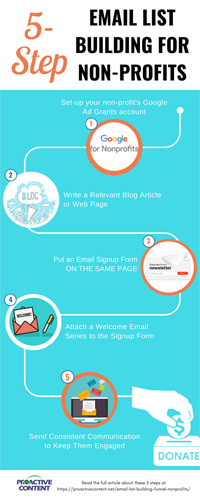Nonprofit Blogs: Why Your Charity Should Be Producing Content Even If Hardly Anyone Else Is
7 Donor-Attracting Benefits of Content Marketing 55% of Nonprofits Are Ignoring
Booming site traffic. A growing email list. Brand and site authority. An engaged and active audience. Steady streams of new donors.
Does that sound like something your nonprofit would love?
 Well you can have it if you commit to producing blogs and other forms of online content marketing. And the good news (or sad news, depending on how you look at it) is that hardly any other nonprofit blogs are active. So even the smallest nonprofit can look like a giant in the online world by producing quality content.
Well you can have it if you commit to producing blogs and other forms of online content marketing. And the good news (or sad news, depending on how you look at it) is that hardly any other nonprofit blogs are active. So even the smallest nonprofit can look like a giant in the online world by producing quality content.
According to Maximize Social Business, only 45% of nonprofits even have a blog. But from what I’ve seen, far fewer than that are doing anything with them. They often go months without any new articles posted. If 45% of nonprofits have a blog, I’d venture less than 15% actually use them for their full potential.
The benefits of a blog are real, even if you only have a few good posts. But those benefits multiply as you continue publishing. That’s the main point of this article, that you do one of these two things:
- If your nonprofit has no blog (also called content marketing), start one
- If you have a nonprofit blog already, commit to producing more and better content than you are now
Here are seven reasons why every nonprofit should have an active blog and content marketing strategy.
7 Ways a Nonprofit Blog Can Help Your Charity
1. Gives You a New Acronym to be Proud of (SEO)
SEO – search engine optimization – is about drawing traffic to your site, and converting that traffic to take the actions you want them to take.
The only way to consistently strengthen your SEO is to produce consistent content. There are probably a billion websites by now. Most of them are terrible and will be seen by hardly anyone.
The ones that get seen are the ones that show up in search engines like Google and Bing, and showing up there means having strong SEO. For a nonprofit, blogs build SEO just like they do for businesses.
How do you build SEO into your blog content? Find keywords and keyphrases that relate to your mission, and start producing content based on them. Continue doing this, and over time, your site traffic will grow. (Yes, that’s waaay oversimplifying a huge topic. This is about why, not how).
2. Supercharges Your Site Traffic via Google Ad Grants
SEO is great, but it is a slow process. Experts say it takes about 8 months of consistent blogging before your traffic numbers and conversions really start to accelerate from SEO alone. And that’s doable. 8 months isn’t that long. But it does take commitment.
Google Ad Grants, however, allows you to capitalize on your nonprofit’s best blog content immediately.
Ad Grants is a free online service only for nonprofits, on the same platform as paid Google Ads. It gives nonprofits $10,000 in free ads every month. When your nonprofit creates a blog, you can create Google ads that will draw people to each blog article.
Learn how to set up Google Ad Grants – free in-depth guide
With Google Ad Grants, your traffic will go up much faster than with SEO alone. One ProActive Content client drew thousands of new visitors to their site from a single blog article that touched on a hot button issue (a good strategy). Many of those visitors commented. Some joined the email list, and some became donors. That’s how it works.
 But we wouldn’t have gotten those thousands of visitors just relying on SEO.
But we wouldn’t have gotten those thousands of visitors just relying on SEO.
Ad Grants is like SEO on steroids. But be warned: It’s a serious pain to set it up. The free guide I created is very detailed, and very clear up front about whether your nonprofit is ready for Ad Grants or not.
I’ll save you some trouble though: If you don’t have a nonprofit blog or much other content yet, you aren’t ready for Ad Grants. So get your blog going first, and come back to Ad Grants after you’ve got a few under your belt and understand how to create the kind of content that works in Ad Grants.
ProActive Content can help you create high quality blog content if you’re not sure what “quality” means in the online world (good news: most don’t). We can give you a blueprint for how to do it and let you do the work, or you can also have us create the content for you if you lack the time, personnel, or expertise.
Reach out for help with your nonprofit blog
3. Builds Your Email List (#1 Reason to Have a Nonprofit Blog!)
With more content comes more opportunity.
Each blog article created by your nonprofit is an opportunity for someone to find you online, whether by organic search (SEO), Google Ad Grants, social media sharing, email, or elsewhere.
But being found means little if nothing happens after that.
The number one – by far – value of having an active nonprofit blog is to build your email list. You should have a prominent and easy-to-find email signup form on every single blog page on your site.
That way, anyone who finds any of your blog articles (why you want a lot of them – more chances to be found) and likes what they see can immediately sign up for your list.
Once signed up, you can communicate with them more personally and consistently over email.
For the same reason, every blog article should also have social sharing and following buttons.
Blogs are how you get found. But they’re also the key to building your list.
See infographic for how to build a nonprofit email list
4. Takes Control of Your Story, Brand, Public Image
Credit for this one goes to Capterra.
Publicity and image are in peril these days for everyone. All it takes is one bad tweet and your world can be thrown asunder.
But if people hear something negative about your charity, and then come to your site and see pages and pages of high quality content, they’re going to be less likely to give much weight to the negative idea.
A quality nonprofit blog automatically builds trust and authority in the positive sense too (just as it does in business – social authority is powerful!)
Use your nonprofit’s blog to tell your story, get your name out there, communicate what’s going on, and share impact. And that leads to #5.
5. Shows Your Impact Through Story
Story is still king. Use your nonprofit blog to share impact stories about how your nonprofit is helping people and making the world better. Donors need stories to motivate them to give. So do your site’s visitors.
Telling stories on a blog is different than telling them in an email or a direct mail letter. One key difference is audience. Direct mail usually goes to donors or potential donors. Email only goes to your current list.
But stories on your nonprofit blog are available to everyone who finds them. You write for a broader audience. You write to draw in, to arouse curiosity, to activate emotions, to inform, and to inspire action.
6. Gives People Something to Talk About
 Whether at live events, personal conversations between your supporters and friends, social media, email, networking events – good blog articles give people something to talk about.
Whether at live events, personal conversations between your supporters and friends, social media, email, networking events – good blog articles give people something to talk about.
You’re keeping your supporters and followers educated and aware of what’s going on.
For instance, suppose your charity fights domestic violence. Don’t just plaster us with statistics all the time (though on blogs – that’s a good idea for some articles because people search for them).
But also, write about domestic violence against women, against men, among certain ethnic groups, and more specialized demographic categories. Write about what government is doing about domestic violence. Write about what causes it, the signs it’s happening to a friend, the signs it might be happening to you. Write about people who’ve escaped it. Write about people who failed to escape it and died or got seriously injured. Write about verbal and emotional abuse.
Do you see how many topics there are in just this one issue? You could come up with five times this many if you thought about it. Endless. And you can hit some of them multiple times.
When people who care about domestic violence find these articles and see you as an authority on the subject, what will they do? They may:
- Join your email list
- Share your stuff on social media
- Make a comment on your page
- Donate
- Volunteer
- Keep coming back for more

- Tell a friend
If you don’t have a nonprofit blog, what will people do when they find your site?
Trick question – because hardly anyone will. A site without content is like a bug zapper with a burnt out light. It won’t attract anything but dust.
7. Gives Voice to Perspectives People Need to Hear
Who writes your blog articles?
It may be a professional content writer (such as ProActive Content). It may be your executive or development directors (if they have the time). But your nonprofit’s blog will be richer and more engaging if you include articles written by other people as well, such as:
- Volunteers (“here’s what happened when I showed up to help!”)
- Office staff – show the world how vital the people are behind the scenes, and how much they care
- Donors (“This is why I give”)
- People You Serve
The last one is priceless. If you can get people who benefit from your services to write about how your nonprofit has changed their life – do it. Grammar doesn’t matter. Someone else can fix the spelling. But leave some errors unedited. It’s more authentic.
Yes, a professional online content writer is essential if you want to maximize SEO value and get everything you can out of your blog. And to be clear, a professional blog writer is not a person with a college degree in writing. A degree is beyond irrelevant. Content writing is a particular skill that is learned by doing it and learning from experts. They don’t have college programs for this kind of writing.
But a well-rounded and diverse nonprofit blog should have multiple writers and multiple perspectives if you want maximized impact.
Click the button above and talk with us about your nonprofit’s blog. After the call, you’ll be given a plan for how to get started, or how to build on what you already have.
Want a complete website content marketing audit?


